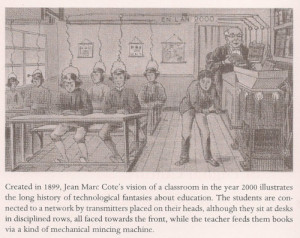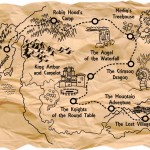Continuing from my previous post — I just couldn’t wait to share those two videos — So, back to Latour.
Let me start by saying — Flick’s facial expression in the image below captures my mindset while trying to correlate Latour and Spinuzzi‘s dance of AT-ANT. I rather feel as though Spinuzzi tossed me a lifeline toward getting a better handhold on Latour’s theory (which he says is not a theory at all), but I’m not quite on safe footing yet. In fact, even as I reread my marginalia, I find myself jotting down still MORE questions. So, to be safe, in this blog I’ll focus only on a few passages and concepts that provided discernible leverage for me on this climb.
1. Several of Latour’s ideas in the latter part of the book stood out to me, but I think it’s worth focusing on the chapter in which Latour creates an imaginary dialogue in the chapter entitled “The Difficulty of Being An ANT.” Specifically, Latour’s assertion that ANT is a “negative argument” (141) at first seemed appropriate given the rather adversarial quality of his argument, and given Spinuzzi’s side-by-side look at AT and ANT as voices commonly treated as competing theories. But Latour also claims that it is “by comparison with other competing ties that any tie is emphasized” (32). Doesn’t a “negative argument” suggest a counter or negation rather than an illuminating relief, or potential “tie”? Certainly, that is how Spinuzzi approaches it, if I’m reading him correctly, when he writes on page 72 that such “contradictions” should be treated — not as binaries or negations — but as “historically accumulating structural tensions within or between activity systems” (quoting Engestrom). Indeed, I’m rather partial to the notion that we find more productive theorizing potential when we focus our lenses on areas of tension, borders (why, hello again, Monsieur Foucault), or threads of activity / movement. So, I seem to be standing on a bit of a fulcrum, but I find Spinuzzi’s approach to competing theories of networks to be a more compelling approach to this mapping expedition. Rather than choosing one path over another, seeking “common ground” (94) may be the more productive means of understanding these two lenses … reminding me at this very moment of our Case Study approach to a single Object of Study. Rather than seeing the dissensions as nodes of work-stoppage, I think I’ll find more productive leverage by seeking out — as Spinuzzi suggests — nodes or “points at which the approaches can inform each other” (95).
So, yet again, the borders are our friends — but what does that border look like? Is it a place? A space? An unseen trace? An actant? An acton? A Theoretical domain (like cultural historical nodes)? A form? Is it the destination or the journey we need to be theorizing?
2. Latour’s critique of frameworks (137) led to a marginal comment of mine: “is this how a MOOC becomes a contested object / space when treated only as a genre of pedagogy / class type?” Latour points to the dangers of “descriptions” vs. “explanations” in his “Fifth Source of Uncertainty” chapter, which reminded me of a MOOC article I’m reading as part of my 2nd case study. He argues that once “a site is placed ‘into a framework’, everything becomes rational much too fast and explanations begin to flow much too freely” (137). I’m struck by how composition pedagogy over the decades has gone through stages of envisioning what “the perfect teaching classroom” should look like — from the Banker’s Model described by  Freire (see image on left on the predictions of an 1899 artist) to the “sage on the stage” to the student-centered / collaborative classroom we boast of today. But online classrooms have become contested borders, defining the “best” classroom model through the f2f standard. As Johnson-Eilola points out in Angels, the “nostalgia” (22) effect could be what Latour is describing as a “framework” into which all of our notions of learning are sealed. Is that what we want? Is that what a MOOC might challenge? And aren’t frameworks sometimes good things?
Freire (see image on left on the predictions of an 1899 artist) to the “sage on the stage” to the student-centered / collaborative classroom we boast of today. But online classrooms have become contested borders, defining the “best” classroom model through the f2f standard. As Johnson-Eilola points out in Angels, the “nostalgia” (22) effect could be what Latour is describing as a “framework” into which all of our notions of learning are sealed. Is that what we want? Is that what a MOOC might challenge? And aren’t frameworks sometimes good things?
3. Further, Latour defines a network as “a tool to help describe something, not what is being described.” I think this semester we’ve seen it applied effectively as both, and I wonder if it’s possible to use it only as one rather than the other, given the nature of network-noun / network-verb. There was a part of the Latour dialogue that led me down one of those “rabbit trails” that seem more and more purposeful, especially if we are to accept Latour’s claim that these trails are really where our focus should be.
4. Finally, back to the imagined conversation between student and professor. Question: “what can it do for me?” (Latour 141). Answer: ANT is “a theory…about how to study things, or rather how not to study them — or rather, how to let the actors have some room to express themselves” (141). The learned professor goes on to point out that this may prove especially useful when “things are changing fast” and traditional theoretical frameworks are simply too rigid to follow suit. For my object of study — composition MOOCs — this may be useful. But wait — isn’t an anti-frame a frame itself? Latour-in-cognito-as-Professor observes that ANT “says nothing about the shape of what is being described with it” (142) — I rather like his twist on the word “worknet” as opposed to “network” (143) — but we are treating all of these theories as ways of framing a discussion about objects of study, a way of thinking and articulating concepts in a way that applying them in a practical way is more than possible — it’s productive. Does this mean that in exploring the ANT along all its twists and turns, it is more an “actor / actant” than a theory-as-tool?
There are plenty of other questions like these in my book margins, but I’m also finding a need for a running list of the vocabulary — especially since some of the terms are being contested and applied in varying ways. I’ve only just started creating this gloss, but I did locate a helpful List of Key Terms for Latour, while others that I’ll need to keep track of are:
- Controversy – tracing the Nodes, connections
- Actors
- Informants
- Intermediaries
- Mediators
Works Cited
Latour, Bruno. Reassembling the Social: An Introduction to Actor-Network Theory.” New York: Oxford UP, 2005. Print.
Spinuzzi, Clay. “How Are Networks Theorized?” Network: Theorizing Knowledge Work in Telecommunications. New York: Cambridge UP, 2008. Print.



One Response to Latour & Spinuzzi Together Again: Reading Notes Post part II